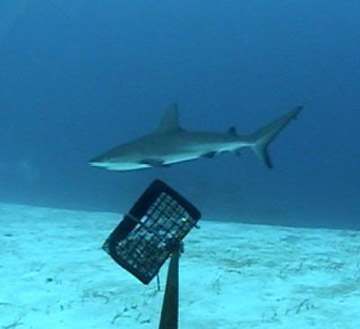Remote camera traps, which have become a hugely important conservation tool on land during the past decade, have now gone underwater. Marine biologists have used underwater video camera traps to compare the population of Caribbean reef sharks (Carcharhinus perezii) in Belize’s protected areas versus fishing areas in a new study in the open-access journal PLoS ONE. Conducted from 2005-2010, the study found that reef sharks benefited significantly from conservation areas.
“Scientists who study tigers or jaguars in the wild use camera traps to count them. It is just as difficult to count sharks in the ocean, so we took a page from the big cat researchers’ playbook and deployed baited video cameras to count the sharks,” explained Demian Chapman, leader of the research team and assistant director of science of the Institute for Ocean Conservation Science at Stony Brook University, in a press release. “It’s only fitting since these large apex predators are the ‘big cats’ of the sea, and like their feline counterparts, their continued existence on Earth is threatened.”
 Filmed at Glover’s Reef Marine Reserve, this footage shows a sub-adult Caribbean reef shark (Carcharhinus perezi) swimming near the bait cage of one of the baited remote underwater video cameras, nicknamed “chum cams,” used in the study.. Photo by: Institute for Ocean Conservation Science at Stony Brook University. |
To document the presence of sharks, scientists employed 200 “chum cams,” remote video camera traps that were baited specifically for sharks with chum in two protected areas in Belize (Glober’s Reef and Caye Caulker) and two fishing reefs. This allowed researchers to spy on sharks in four different management areas.
“This study now presents visual proof that large, active sharks are also dramatically more abundant inside these protected areas, too,” said Mark Bond, lead author and doctoral student at Institute for Ocean Conservation Science. “Nearly four times as many chum cam deployments in the marine reserves recorded reef sharks than on similar fished reefs. These areas provide the sharks and other coral reef species a respite from fishing, which means decreased fishing mortality for the sharks and more prey for them to eat.”
By tagging 34 reef sharks with acoustic transmitters, the researchers were also able to determine that many sharks live in the protected areas all year.
Currently the Caribbean reef shark is listed as Near Threatened on the IUCN Red List. It is a target of certain fisheries and also often caught as by-catch.
“Our study demonstrates that marine reserves can help protect shark species that live on coral reefs. Moreover, the use of underwater video monitoring provides us with an excellent tool to determine if populations are recovering and thriving inside these reserves,” concludes co-athor Ellen K. Pikitch, theexecutive director of the Institute for Ocean Conservation Science.
CITATION: Bond ME, Babcock EA, Pikitch EK, Abercrombie DL, Lamb NF, et al. (2012) Reef Sharks Exhibit Site-Fidelity and Higher Relative Abundance in Marine Reserves on the Mesoamerican Barrier Reef. PLoS ONE 7(3): e32983. doi:10.1371/journal.pone.0032983.
Related articles
Costa Rican fishermen plundering Colombian waters for sharks
(10/14/2011) Costa Rican fishermen have killed some 2,000 sharks in Colombian waters off Malpelo island, a protected area renowned for its marine life, reports Colombia Reports.
California governor signs ban on shark fin trade
(10/10/2011) California governor Jerry Brown on Friday signed legislation banning the the importation, possession and sale of shark fins in California.
Marshall Islands creates world’s biggest shark park
(10/03/2011) The Republic of the Marshall Islands has created the world’s biggest shark reserve: so large that all of Mexico could fit comfortably inside. With new legislation, commercial shark fishing is now completely banned in Marshall Islands’ 768,547 square miles (1,990,530 square kilometers) of ocean.